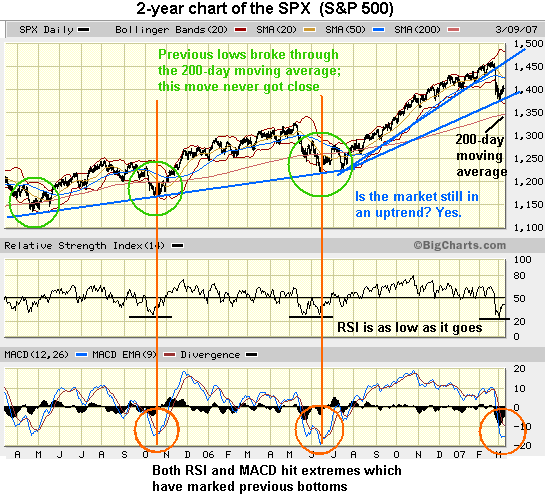

|
| weblog/wEssays archives | home | |
|
The Bull: Only a Flesh Wound? (March 13, 2007) Back on February 26 I posted some charts to support the view that the market was ripe for a sharp fall, which occurred the following day. So is the Great Bull Market fatally wounded? On March 5 I posted some charts to suggest that maybe this was the start of decline which would take a month or three to reach a real bottom, a la last year's May-June downleg. Just to play Devil's Advocate, here is a chart which suggests the downturn might only be a flesh wound. The problem with predicting market behavior, of course, is that as soon as the consensus prediction becomes known then the market refuses to comply. I am seeing a lot of stories calling for another sharp leg down after this current bounce runs out of steam, and this certainly has plenty of history to support it. But look at this chart with unjaundiced eyes: 
I promised to work other topics other than the stock market but it seemed churlish not to mention that the market looks like it may have already hit bottom. Long-time readers know I (along with many others) expect the global markets to blow up at some point-- probably when the $370 trillion derivatives casino blows up. But until that explosion occurs, the market looks like it might shake itself off and head up to new highs. If you look at RSI (relative strength) and MACD (there are dozens of indicators, but these are easy for me to follow), then it's pretty obvious they've hit extreme lows--more or less on par with the lows of recent market drops/corrections. It's certainly possible to hang around these "oversold" extremes for some time, or fall back down in a "re-test". And perhaps this will happen. If it were easy to tell what the market will do next, we'd all be millionaires. Previous corrections took the SPX below its long-term trendline of the 200-day moving average. This drop never even got close to the 200-day MA. As for the uptrend: the steep uptrend from last July's lows was broken, but if you look at the 2-year chart, you can see that the uptrend, while damaged, isn't definitively broken. Maybe this downleg won't be over until the 200-day MA is tested. Several correspondents have speculated that the market will continue its bullish ways until the September-October timeframe; others have suggested the S&P 500 will run to 1445, drop back to 1325 (breaching the 200-day MA) and then run to a new high around 1550. Such as "sawtooth" pattern is typical, and so this is also plausible. As we all know, the trend is your friend--until it isn't. Are the speculative forces supporting the global bull market rotten to the core? Yes, absolutely. But as I have been learning, though charts don't reflect the whys and wherefores, they do help us discern the trend. Just as the charts suggested a sudden break in the trend on February 26, and a hesitancy on March 5, they also allow for a return to the underlying bullish trend--at least until evidence suggests otherwise. For more on this subject and a wide array of other topics, please visit my weblog. copyright © 2007 Charles Hugh Smith. All rights reserved in all media. I would be honored if you linked this wEssay to your site, or printed a copy for your own use. |
||
| weblog/wEssays | home |